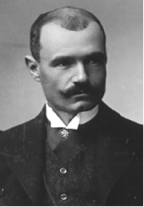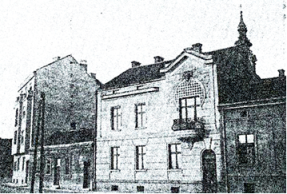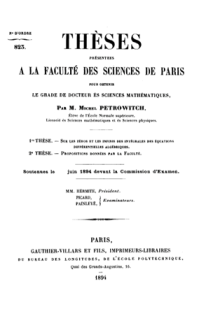 The website is in construction. New files will be uploaded as soon as they are available.
The website is in construction. New files will be uploaded as soon as they are available.
MIHAILO PETROVIĆ
Belgrade 1868 - Belgrade 1943

- Brief scientific bibliography
- His commitment to Education
- Essential bibliography
- Articles on the teaching of mathematics
Brief scientific biography
Mihailo Petrović was born 6 May 1868 in Belgrade (sometimes also cited as 24 April, due to the differences in calendars), eldest child of Nikodim, a professor of theology, and Milica (neé Lazarević). Of a middle-class background, he completed his primary (1878) and secondary schooling (1885) and undergraduate studies in Belgrade, the latter at the Superior, or sometimes called the Great School, in 1889. He then went on to study at the école Normale in Paris, originally a teacher training institution.

House in which Mihailo Petrović was born in 1868, Kosančićev Venac no. 22, Belgrade
Both Petrović and Painlevé later gained friends from the political elites of their respective countries. In 1906 Painlevé became a Deputy for the fifth arrondissement, the so-called Latin Quarter. He later became Prime Minister twice, in 1917 and 1925. Petrović on the other hand, became first tutor, and later good friend of the Crown Prince George Blackgeorge (Djordje Karadjordjević, 1887-1972). Petrović and Painlevé continued their friendship upon the return of Petrović to Belgrade. At Petrović's insistence Painlevé's work on mechanics (PAINLEVÉ, 1922) was translated by Ivan Arnovljević and published in 1828 in Belgrade as a textbook under the title Mehanika (Mechanics).
Petrović also made friends with Charles Hermite, who had already had another Serbian student, Mijalko ćirić. Hermite taught Petrović higher algebra, and his son-in-law, Emil Picard, was another of Petrović's examiners. Petrović and Picard became life-long friends, and Picard drew on work from Petrovitch's thesis in his Traité d'Analyse (1908) (TRIFUNOVIĆ, 1994, 27).

Frontispiece of the Petrović's thesis
In the years prior to the First World War, he also worked on mathematical phenomenology, with a view to developing a mathematical apparatus which would be able to encompass 'all facts', and link apparently unconnected phenomena in a mathematical fashion (PETROVIĆ, 1911). His work on cryptography established the science in Serbia, and later, Yugoslavia. As an outcome of this work during the First World War he founded the theory of mathematical spectra, which has analogies with the spectral method in chemical analysis. This theory consists of dispersing unknown quantities from a problem into a numerical spectrum. The unknown quantities are dispersed, separated and determined in the same way as spectral analysis is done in chemistry. This theory was to be applicable to arithmetic, algebra, and infinitesimal calculus, and Petrović taught a course on it at the Faculté de sciences at the University of Paris in 1928 (PETROVIĆ, 1919 and 1928).
Apart from being an extremely prolific mathematical author, Petrović was also one of the most universally liked individuals from the Serbian intellectual history. His love of mathematics and the ease with which he made friends with people in high places as well as the local people and the gypsies (he had his own band, which recorded more than two thousand Gypsy music songs for Radio Belgrade between the two World Wars), his love of fishing, and his curiosity about all natural phenomena (for example one of his works on fishery was entitled Do fish sleep?, published in Belgrade in 1897), made him a role model for many a young Serbian mathematician. The following two anecdotes give some illustration of his quirky appeal. In one case he wrote to his mother after attending a Presidential ball in Paris, forbidding her to tell anything about it to the neighbours for two reasons, a) no one would believe her, and b) his gypsy friends would take offence. On another occasion, after the mathematical institute in Belgrade was named after him in 1938, Petrović was asked to give a statement for the national press (this was the only press statement he ever gave), and his reply was contained in one sentence: "God will be my witness that none of this was my fault".
During his tenure at the University of Belgrade, Petrović delivered some sixteen different courses in mathematics, for half of which he produced notes, and published three textbooks based on his teaching. His opus includes some 257 published papers, five registered patents, ten monographs, and thirty-one articles and books on subjects ranging from fishing and the history of piracy (of the ancient, seaman type) to ethnography and travelogues.
His commitment to Education
Serbia changed relatively rapidly from having little or no mathematical culture at the beginning of the nineteenth century to having a thriving mathematical life under the leadership of Petrović. There were some advantages to this relatively short history. At the International Conference on Mathematics Teaching (La Conférence International de l'Enseignement Mathématique) in Paris held in April 1914, the Serbian representative reported that the introduction of infinitesimal calculus into schools was devoid of problems in their country; modernization did not pose a problem in a place where there was no tradition which could inhibit it:
"Chez les nations qui ont à peine dans leur développement, passé les premiers seuils de la civilisation, il n'y a pas de tradition et une idée en general et surtout une idée nouvelle, devient très facilement l'idéal meme d'une generation. Par consequent, dans ces circonstances la realisation de cet ideal n'est pas empêchée ou retardée par des questions de tradition." (L'Enseignement Mathématique, 16 (1914), 332-333: "In nations which are but at the threshold of civilization in their development, there is no tradition and an idea in general and especially a new idea, can very easily become an ideal of a new generation. As a consequence, in such circumstances the realization of this ideal is not prevented or delayed by the questions of tradition.)It was Petrović who established a new tradition of teaching and learning of mathematics in Belgrade, and Serbia in general. His work in education led him to attend the international congresses as a representative of a small country which was only beginning to build its mathematical school. He not only established a mathematical school in Serbia, but introduced a new spirit of learning at the University of Belgrade. Through his personal efforts the library there grew steadily to include the main mathematical journals of the times, and he was said to have encouraged his students to learn from the sources they themselves found in this library - a new approach to learning in the times when learning by rote was still very much the modus operandi.
His efforts to establish a national school (virtually all mathematical doctorates in Serbia between the two World Wars were done under his supervision) established far-reaching change in mathematics of the Balkans. Petrović's doctoral students were Sima Marković (who earned his Ph.D 1904 and became a famous Communist and as such disappeared and lost his life in Russia under Stalin), Mladen Berić (1912), Tadija Pejović (1923), Radivoj Kašanin (1924, who became professor at the University of Belgrade), Jovan Karamata (1926, who taught mathematics at the universities of Belgrade, Götingen, and Geneva), Miloš Radojćić (1928, professor at the University of Belgrade and the University of Khartoum), Dragoslav Mitrinović (1933, professor of mathematics and founder of mathematical institutes in a number of universities of former Yugoslavia), Danilo Mihnjević (1934), Konstantin Orlov (1934, professor of mathematics at the University of Belgrade), and Dragoljub Marković (1938).
These mathematicians, the pupils of Petrovic, jointly produced a further 361 doctoral students during their professional lives. This had a long-term effect on Serbian, and later Yugoslavian, study of mathematics in the first half of the twentieth century. In this way the influence of the French school was felt long after its main Serbian student became the founder of the national mathematical school.
Petrović's dedication to education extended to his belief that communication with the world must be part of the practice at the university. In 1914 he suggested to the Serbian Royal Academy that all scientific communications contain an abstract in French or German. From 1922 this became a standard practice, and it later included translations into English. Petrović was also one of the founders of the journal Publications mathématiques de l'Université de Belgrade in 1932.
Essential Bibliography
J. KEČIĆ 1998, Mihailo Petrović (in Serbian), in Život i delo srpskih naučnika, 3, Belgrade, SANU
D. MITRINOVIĆ 1968, Mihailo Petrović: man, philosopher, mathematician (in Serbian), Belgrade
D. MITRINOVIĆ 1968, Life of Mihailo Petrović (in Serbian), Matematička biblioteka, Belgrade, vol. 38, 7-32
A. PETROVIĆ 2004, Development of the first hydraulic analog computer, Archives Internationales d'Histoire des Sciences, vol. 54, 153, 97-110
M. PETROVIĆ 1894, Sur les zéros et les infinis des intégrals des équations différentielles algébriques, thesis presented at the Faculty of Sciences, Paris, No. 823, Paris, Gauthier-Villars
M. PETROVIĆ 1894, Sur les intégrals uniformes des équations différentielles du premier ordre et du genre zéro, Compte rendus hbdomadaires des séances de l'Academie des Sciences, Paris, 1190-1193
M. PETROVIĆ 1895, O asimptotnim vrednostima integrala diferencijalnih jednacina, Belgrade
M. PETROVIĆ 1896, Sur l'equation différentielle de Riccati et ses applications chimiques, Sitzungberichte der Königl - Böhmischen gesellschaft der Wissenschaften, Prague, 1-25
M. PETROVIĆ 1896, Contribution à la théorie des solutions singulières des équations différentielles du premier ordre, Mathematische Annalen, Leipzig, 103-112
M. PETROVIĆ 1899, Sur une manière d'étendre le théorème de la moyenne aux équations différentielles du premier ordre, Mathematische Annalen, Leipzig, 417-436
M. PETROVIĆ 1908, Procédé élémentaire d'application des intégrals définies réelles aux équations algébriques et transcendants, Nouvelles annals de mathématiques, Paris, (4) 8, 1-15
M. PETROVIĆ 1911, Elements of Mathematical Phenomenology (in Serbian), Belgrade, Serbian Royal Academy of Science
M. PETROVIĆ 1919, Les spectres numériques, Paris, Gauthier-Villars
M. PETROVIĆ 1928, Leçons sur les spectres mathématiques (professées à la Sorbonne en 1928), Paris, Gauthier-Villars
M. PETROVIĆ 1929, A contribution to history of a problem in the theory of functions (in Serbian), Belgrade, Glas vol. 134, 87-90
D. TRIFUNOVIĆ 1944, Doktorska disertacija Mihaila Petrovica, Belgrade, Arhimedes
Articles on the teaching of mathematics
M. PETROVIĆ 1913, International commission on mathematical instruction (in Serbian), Prosvetni glasnik, Belgrade, 724-731
M. PETROVIĆ 1926, French mathematics (in Serbian), Letopis Matice srpske, Novi Sad, 207-220
M. PETROVIĆ 1928, Cryptography, school on teaching the science in fourteen books (in Serbian), Kraljevina Jugoslavija, Glavni generalštab, Odeljenje obaveštajno, Odsek za šifre, Belgrade
M. PETROVIĆ 1928, Issues about the ways logarithms are taught (in Serbian), Glasnik profesorskog društva, Belgrade, 368-370
M. PETROVIĆ 1932, (with B. Gavrilović and I. Djaj), Guidance on publishing in foreign languages for mathematical and natural sciences (in Serbian), Srpska Kraljevska Akademija, Godišnjak, Belgrade, 280-283
M. PETROVIĆ 1932, On dependence between magnitudes in mathematical problems (in Serbian), Matematički list za srednju školu, Belgrade, 273-276
M. PETROVIĆ 1933, The mistakes mathematicians make (in Serbian), Glasnik Jugoslovenskog profesorskog društva, Belgrade, 874-881
Author
Snezana Lawrence
Simon Langton Grammar School
Canterbury CT4 7AS
United Kingdom
snezana@mathsisgoodforyou.com
